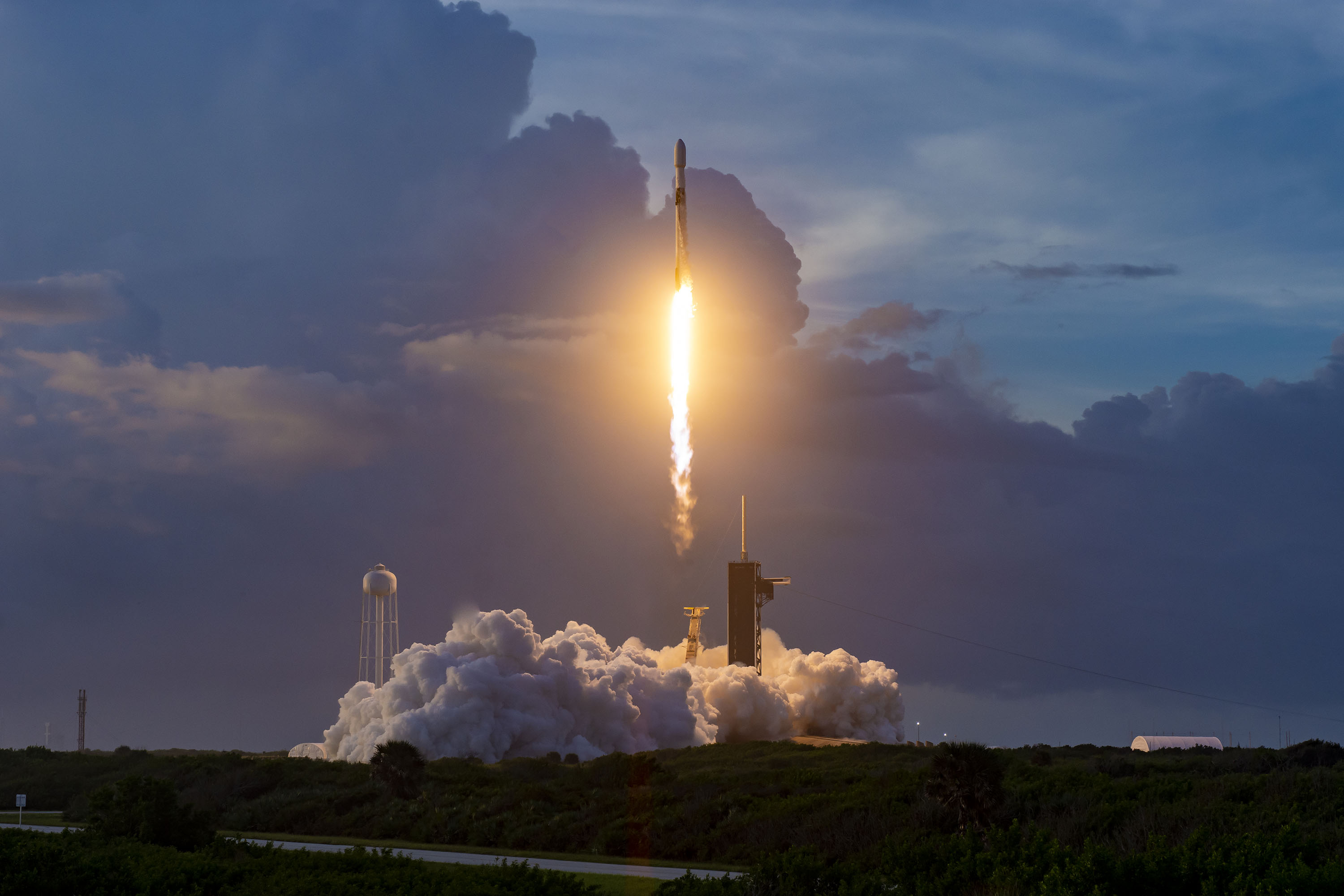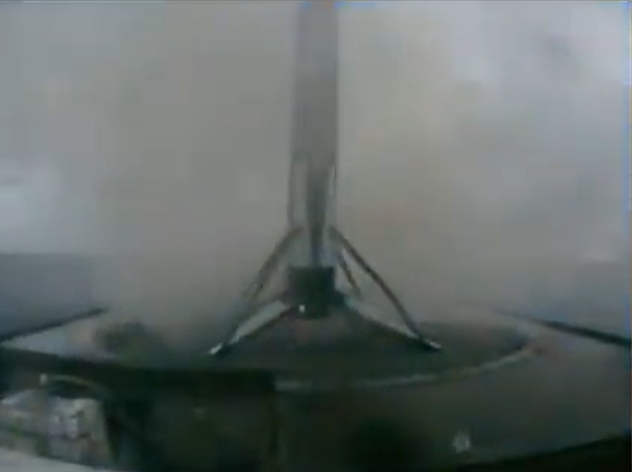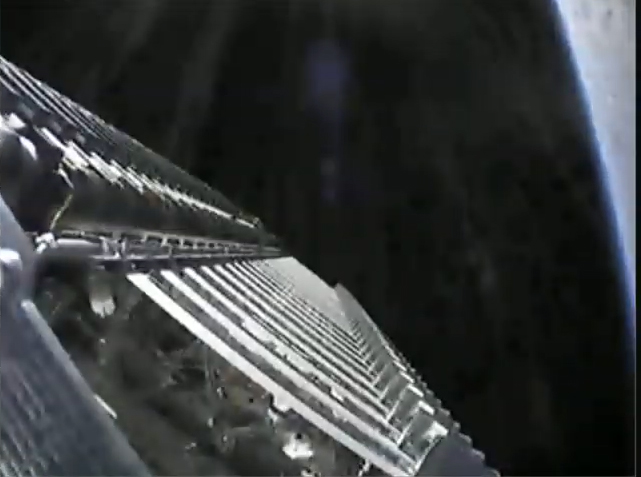SpaceX launches 60 Starlink satellites and lands rocket at sea
CAPE CANAVERAL, Fla. — SpaceX delivered its 13th batch of Starlink satellites to orbit Tuesday (Oct.6), following a two-week delay due to bad weather.
The two-stage Falcon 9 rocket blasted off from Pad 39A at NASA's Kennedy Space Center at 7:29 a.m. EDT (1129 GMT), hauling a full stack of 60 Starlink satellites. Approximately 9 minutes later, the booster's first stage came back to Earth, landing on one of SpaceX's drone ships in the Atlantic Ocean.
The launch marks SpaceX's 17th mission so far in 2020, and its 94th Falcon 9 flight to date. The company's fleet of flight-proven boosters has been busy this year, with the California-based rocket builder reaching a few new milestones, including launching and landing the same first-stage booster six times.
The launch also came amid World Space Week 2020, which is celebrating the impact satellites have on everyday life.
Related: SpaceX's Starlink satellite megaconstellation launches in photos
Poor weather conditions at Falcon 9's ocean recovery site forced SpaceX to stand down from its first attempt to launch this particular Starlink mission on Sept. 17. Weather concerns also thwarted a launch attempt on Sept. 28 and Oct. 5; while ground systems issues prevented the rocket from flying on another attempt on Oct. 1. But the fifth time was the charm today, with Mother Nature finally cooperating for a smooth launch.
"A happy end to Scrub-tober," SpaceX integration and test engineer Siva Bharadvaj said during live commentary after the Starlink satellites were successfully deployed.
Get the world’s most fascinating discoveries delivered straight to your inbox.
The weather was iffy this morning as a brief rain shower and patch of cumulus clouds rolled in, but the skies cleared as the minutes ticked away. Onlookers cheered as the Falcon leapt off the pad, signaling an end to the series of launch aborts and weather scrubs that have recently plagued the Space Coast.
Related: Why SpaceX's Starlink satellites caught astronomers off guard
A veteran booster
The booster powering today's launch is a previously flown Falcon 9 first stage that the company has identified as B1058.3. This booster, now with three flights under its belt, previously carried two NASA astronauts to the International Space Station on May 30 as part of SpaceX's historic first crewed mission. The rocket then lofted a communications satellite for South Korea's military in July.
Emblazoned with NASA's iconic worm logo, still visible underneath the booster's scorched appearance from its two trips to space and back, B1058 is one of the newest additions to SpaceX's fleet of frequent fliers. Approximately nine minutes after liftoff, the first stage made another landing, touching down on the deck of the SpaceX drone ship Of Course I Still Love You, which was waiting out in the Atlantic Ocean.
The massive drone ship is one of two used by SpaceX to catch its returning boosters. Of Course I Still Love You has been busy catching boosters this year, alternating duty with its counterpart, Just Read the Instructions. That ship was originally deployed in the Pacific Ocean, but switched coasts earlier this year, and has received a host of new upgrades.
The landing today marked the 61st recovery of a Falcon first stage since SpaceX recovered its first booster in 2015.
Starlink expansion
SpaceX's Starlink megaconstellation is designed to provide global broadband coverage for high-speed internet access, particularly for people in rural and remote areas. Each of the flat-panel Starlink satellites weighs roughly a quarter-ton and are built in-house at a SpaceX facility in Redmond, Washington. (The company also manufactures its own own user terminals and ground stations.)
While SpaceX expects its initial set of Starlink satellites to be 1,440 strong, the company has plans to launch thousands more. Company founder and CEO Elon Musk has said SpaceX needs between 500 and 800 satellites in orbit before service can begin to roll out. SpaceX is inching closer and closer to that goal, as it has delivered nearly 800 into orbit so far.
The Federal Communications Commission has granted SpaceX permission to launch as many as 12,000 of the flat-panel broadband satellites, but SpaceX may not stop there. The company has indicated it will see approval to launch as many as 30,000 of its internet-beaming satellites to beam down high-speed, low-latency Internet signals.
Falcon sunrise.📷: Me for @SuperclusterHQ pic.twitter.com/oUlwfOF8A9October 6, 2020
SpaceX's Starlink system is currently going through a private beta-testing phase, with employees testing out the download speeds. That initial testing will extend to the public later this year. So far, data has shown that the system can support multiple high-definition streams at the same time, company officials have said.
Users on the ground will connect to the burgeoning satellite service via a small terminal (roughly the size of a laptop) for users on the ground. Musk has said he wanted the terminals to be easy to use, and that they resemble a UFO on a stick.
SpaceX has also started testing inter-satellite laser links that would allow data to flow through the network without having to route through ground stations — a feature the initial batch of Starlink satellites (launched in May 2019) did not have. The company has also SpaceX recently asked the Federal Communications Commission if it could add user terminals to its fleet of ships, in particular its two drone ships.
"In order to expand its assessment of the end-to-end capabilities of its satellite system, SpaceX seeks authority to test these user terminals on seagoing platforms for a period of up to two years. Specifically, SpaceX proposes to deploy a total of ten earth stations across up to ten vessels, including two autonomous spaceport drone ships used to land rocket boosters at sea," the company wrote in the FCC filing posted Sept. 15.
The addition of these terminals will allow SpaceX to test its satellite network in the field as well as bolster recovery efforts by equipping its vessels with better communication tools. Remote and rural users as well as those on airliners and ships (such as cruise ships, etc.) are its prime targets, so this would enable SpaceX to really test out its system.
Despite the promise of high-speed, low-latency broadband internet, SpaceX has taken some criticism for its Starlink satellites due to their potential to disrupt astronomical observations of the night sky. Shortly after the first batch's launch last year, astronomers expressed concern that the bright train of satellites marching across the sky will hinder their observations. SpaceX has tried to come up with solutions to help mitigate this issue.
To that end, this is the third batch of Starlink satellites now that are outfitted with a sunshade — a special visor — that the company hopes will reduce the satellite's apparent brightness by reducing the amount of sunlight reflected that’s reflected.
Reusable fairings
SpaceX will attempt to recover the Falcon 9's payload fairing, or nose cone, on today's flight. In fact, one of the fairing halves has already supported two previous Starlink missions — one in May 2019 and one in March 2020.
Each piece of the clamshell-like hardware is outfitted with software that navigates it to the recovery zone, and a parachute system that lets them gently land, either in the ocean or the outstretched net of one of two recovery vessels.
GO Ms. Tree and GO Ms. Chief are both equipped with giant nets that allow them to act as a mobile catcher’s mitt. This massive piece of hardware accounts for 10% of Falcon 9's price tag so recovery efforts allow SpaceX to reduce launch costs and reuse more of its hardware.
The duo is able to scoop the fairing pieces out of the ocean and haul them back to port or catch them as they fall back to Earth. All recovery efforts (either a catch or a scoop) typically occur approximately 40 minutes after liftoff.
Simply having a giant net does not guarantee that one (or both of the boats) will actually be able to make a catch, however; for example, weather also plays a role.
The 60 Starlink satellites are scheduled to separate from the rocket approximately 61 minutes after launch.
Up next for SpaceX is the launch of an upgraded GPS satellite for the U.S. Space Force. That launch is scheduled to blast off from Space Launch Complex 40 sometime in the near future. Teams are investigating an anomaly that occurred on Friday (Oct. 2), which caused an abort just before launch .
Follow Amy Thompson on Twitter @astrogingersnap. Follow us on Twitter @Spacedotcom or Facebook.






